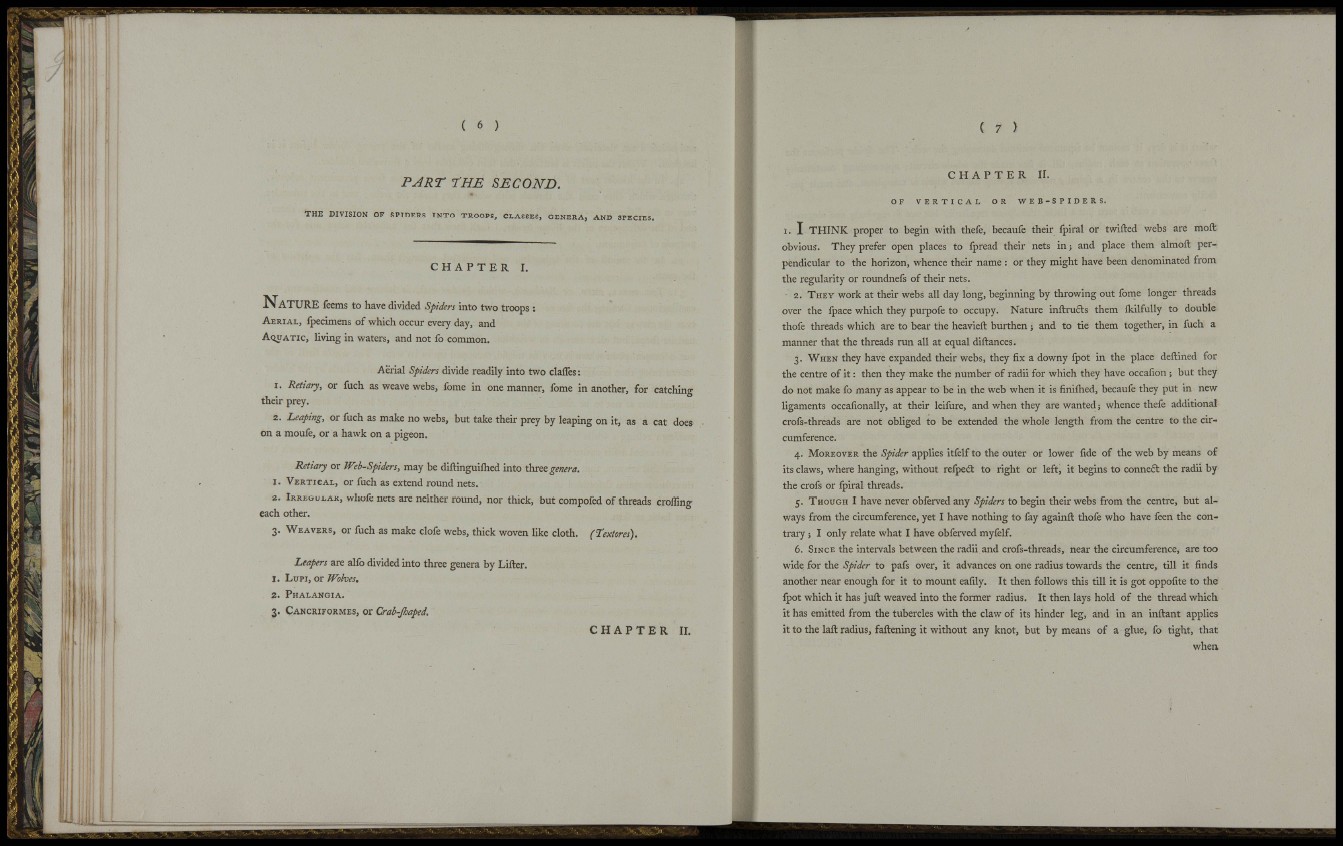
( 7 )
'lili
PART THE SECOND.
THE DIVISION OF SPIDERS INTO TROOPS, CLASSES, GENERA, AND SPECIES.
C H A P T E R i r .
OF VERTICAL OR WEB-SPIDERS.
C H A P T E R I.
NATURE feems to have divided Spiders into two troops :
AERIAL, fpecimens of which occur every day, and
AQUATIC, living in waters, and not fo common.
Aerial Spiders divide readily into two clafles:
1. Retiary, or fuch as weave webs, fome in one manner, fome in another, for catching
their prey.
2. Leaping, or fuch as make no webs, but take their prey by leaping on it, as a cat does
on a moufe, or a hawk on a pigeon.
Retiary or Web-Spiders, may be diftinguifhed into three genera.
1. VERTICAL, or fuch as extend round nets.
2. IRREGULAR, whofe nets are neither round, nor thick, but compofed of threads crofling
each other.
3. WEAVERS, or fuch as make clofe webs, thick woven hke cloth. (Textores).
Leapers are alfo divided into three genera by Lifter.
1. Lupi, or^/u«.
2 . PHALANGIA.
3. CANCRIFORMES, or Crab-Jhaped.
C H A P T E R II.
I. I THINK proper to begin with thefe, becaufe their fpiral or twifted webs are moft
obvious. They prefer open places to fpread their nets in; and place them almoft perpendicular
to the horizon, whence their name : or they might have been denominated from
the regularity or roundnefs of their nets.
2. THEY work at their webs all day long, beginning by throwing out fonie longer threads
over the fpace which they purpofe to occupy. Nature inftrufls them ikilfully to double
thofe threads which are to bear the heavieft burthen; and to tie them together, in fuch a
manner that the threads run all at equal diftances.
3. WHEN they have expanded their webs, they fix a downy fpot in the place deftined for
the centre of it: then they make the number of radii for which they have occafion ; but they
do not make fo many as appear to be in the web when it is finiihed, becaufe they put in new
ligaments occafionally, at their leifure, and when they are wanted; whence thefe additional
crofs-threads are not obliged to be extended the whole length from the centre to the circumference.
4. MOREOVER the Spider applies itfelf to the outer or lower fide of the web by means of
its claws, where hanging, without refpeft to right or left, it begins to conneft the radii by
the crofs or fpiral threads.
5. THOUGH I have never obferved any Spiders to begin their webs from the centre, but always
from the circumference, yet I have nothing to fay againft thofe who have feen the contrary
; I only relate what I have obfei-ved myfelf.
6. SINCE the intervals between the radii and crofs-threads, near the circumference, are too
wide for the Spider to pafs over, it advances on one radius towards the centre, till it finds
another near enough for it to mount eafily. It then follows this till it is got oppofite to the
fpot which it has juft weaved into the foniier radius. It then lays hold of the thread which
it has emitted from the tubercles with the claw of its hinder leg, and in an inftant applies
it to the laft radius, fattening it without any knot, but by means of a glue, fo tight, that
whea
ÜÜ